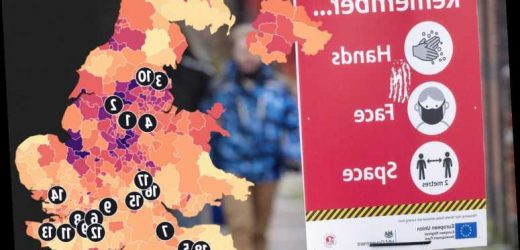A NEW Covid 'belt' has emerged covering the East to the West as new data from Public Health England (PHE) states that cases are still rising in 18 areas.
This interactive map reveals if your area is on the hotspot list as infection rates continue to fall in 93 per cent of local authorities.
? Read our coronavirus live blog for the latest news & updates…
Across the four English regions that cover the East to the West of the country, there are currently over 1.8 million people infected with Covid-19.
This compares to over 3.7 million infections across the whole country, with the 'belt' taking up almost a third of all infections in England.
Outside of the Covid 'belt' and areas such as the North East have some of the lowest infection rates in the country with just over 185,000 infections in the region – compared to London where there are currently over 701,000 infections.
Cases have however fallen in 293 local authority areas and it comes as it was yesterday reported that deaths caused by Covid-19 have plummeted by 80 per cent in just a month.
Another 190 casualties were recorded yesterday and this time last month, 1,001 more deaths were reported.
A further 5,926 people tested positive – a drop of 54 per cent on February 10, when 13,013 people were newly-diagnosed.
The figures are also lower than this time last week, when 6,385 new infections and 315 deaths were recorded.
In hospitals in England, 145 further fatalities were recorded. Patients were aged between 42 and 98, and 12 of the casualties – aged 42 to 84 – had no known underlying health conditions.
The Midlands – currently England's worst-hit region – recorded 41 deaths, while 37 people died in the North East and Yorkshire, 21 in the North West and 16 in both the East of England and London.
A further eight people died in the South East and six in the South West.
While deaths, hospitalisations and infections are all declining, there are still 18 areas in the UK that have witnessed an increase in cases over the last seven days.
In the seven days up to March 6, the Derbyshire Dales saw a huge jump in cases from 63.6 per 100,000 to 160.4.
The area is the most infected in the country and recorded 116 new cases in the last week.
Elsewhere in South Yorkshire, and Rotherham has also witnessed an increase in cases from 148.8 to 151.8 – this is the equivalent of 403 new cases.
The area is covered by The Rotherham NHS Foundation Trusts where at present there are 52 patients in hospital with Covid-19 and just two on ventilation.
In Lancashire, Ribble Valley has seen a rise from 78.8 to 88.7 and in the Midlands, Staffordshire Moorlands has seen a rise from 75.2 cases per 100,000 to 77.2.
Further South and East Devon has witnessed a jump from 41.7 to 59.5.
Basingstoke and Deane increased from 46.4 to 51.5 and the latest data from the Office for National Statistics (ONS) shows that in the last week, four people have died from the virus in the area.
Three of the deaths were recorded in a hospital and one in a care home and it takes deaths in the area since the start of the pandemic to 307.
Another area that has seen a rise in cases is South Somerset, where cases have jumped from 41 per 100,000 to 49.3.
Kingston upon Thames has also seen a rise in infections, jumping from 38.9 to 47.9.
South Bucks has gone from 45.7 to 47.1, while Craven in North Yorkshire has also seen an increase from 31.5 to 45.5.
In Kent and there are two areas that have witnessed an increase in cases.
Ashford has seen infections rise from 39.2 per 100,000 to 41.5 in the last seven days and Canterbury has also jumped from 19.3 to 36.3.
In Surrey, infections have increased in Guilford from 33.6 to 36.9 and in Uttlesford in Essex, they have also increased from 19.7 to 30.7.
Cases in West Oxfordshire have gone from 25.3 to 28.0 and in Cheltenham they have also increased from 26.7 to 27.5.
Tewkesbury in Gloucestershire has also seen a slight increase in cases going from 23.2 to 27.4 and in West Devon cases have also increased from 7.2 to 10.8.
South Hams has the lowest infection rate in the country and currently has just 5.7 cases per 100,000.
Other areas with low infection rates include Eden, Rother and the Isle of Wight.
Source: Read Full Article




